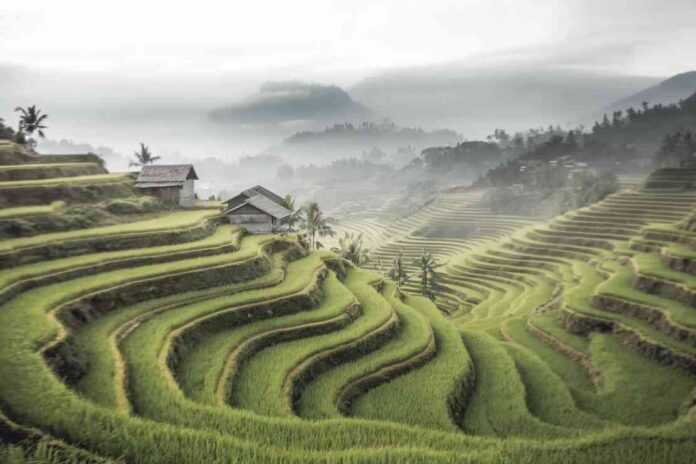Famous for the breathtaking view of rice terraces and cultural heritage, Sapa is located in northern Vietnam. While the expanses of valleys and mountains offer a picturesque view, Villages around Sapa like red Dao, H’Mong , Tay and Giay are the true essence of Sapa’s charm. These villages, inhabited by various ethnic minorities, provide a window into the world of their folk life that has not changed for centuries.
This guide will highlight the enchanting villages near Sapa, exploring their cultural traits, breathtaking sights, and travel tips that will help you enjoy your visit to its fullest. These villages offer unforgettable experiences whether you wish to embark on a short day trip or immerse yourself in a multi-day trekking journey through Vietnam’s northern highlands.
Why Visit the Villages Around Sapa?
Cultural immersion, breathtaking landscapes and unique homestay experiences have all made the villages surrounding Sapa one of the most popular destinations in Vietnam you cannot miss, lets see why.
- Cultural immersion for each village comes in the form of authentic encounters with ethnic minorities who speak and practice their traditions including crafts and languages.
- Breathtaking Landscapes: The towering emerald rice terraces, strong bamboo trees and streams all come together to create the spectacular natural scenery Sapa is famous for.
- Trekking Opportunities: Check off all the villages while taking in their views via picture perfect trekking routes, these trails range from easy strolls to arduous hikes.
- Homestay Experiences: You cannot miss traditional hospitality and cuisine with local family members which is best experienced through traditional homestays where daily life is blended with daily work.
- Handicraft Traditions: Experience centuries worth of weaving, dyeing, silversmithing and embroidery through the eyes of a skilled craftsmen and women.
Best Time to Visit Sapa Villages
The ideal months for trekking in Sapa are from September to November and April to early June. During these periods, the weather is mild, rainfall is minimal, and the trails are in excellent condition for hiking.
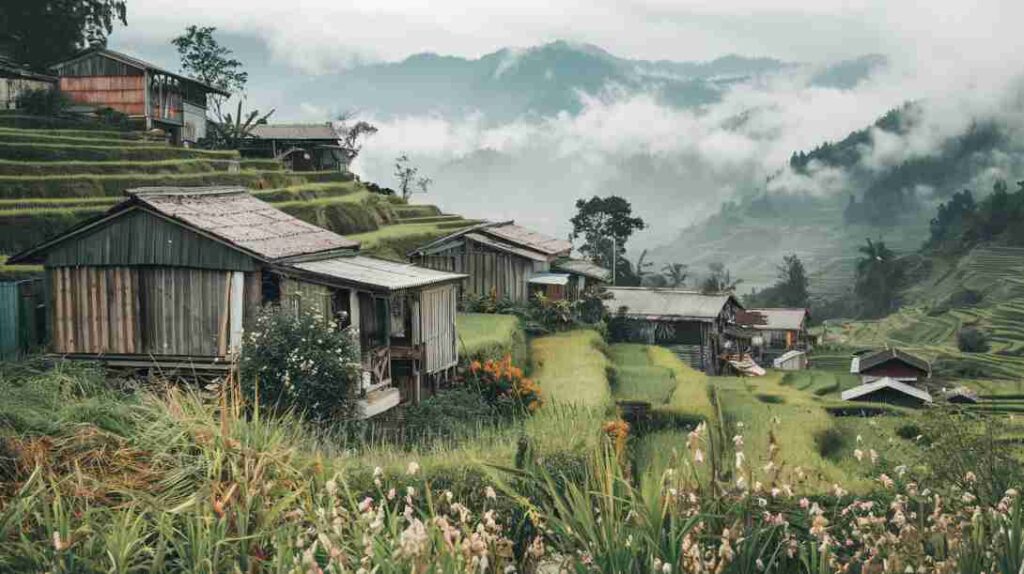
🍂 Autumn Season (September – November)
In Fall, the clear sky and cool weather make Sapa’s climate perfect for sightseeing. This season is especially stunning as the rice paddies turn a golden hue due to the harvest, which creates splendid scenery.
🌸 Spring Season (March – May)
Sapa in spring offers lovely temperatures hovering around 16°C (60°F). The mountains become alive with patches of blooming wildflowers, blooming peach trees, and the landscape turns into an enchanting tableau that is perfect for trekking.
The Top Villages Around Sapa
Cat Cat Village
Just 3 kilometers from Sapa town, Cat Cat is the most accessible and popular village in the region.
History and Cultural Significance
Cat Cat Village history goes way back. It was first founded in the 19th century by the Black H’Mong ethnic minority and was later ‘discovered’ by French colonizers when they set up a hydroelectric power station near the village in the early 1900s. After the French left in 1954, the village was officially named Cat Cat after a waterfall that was referred to as ‘CatScat’ by French Vietnam Discovery.
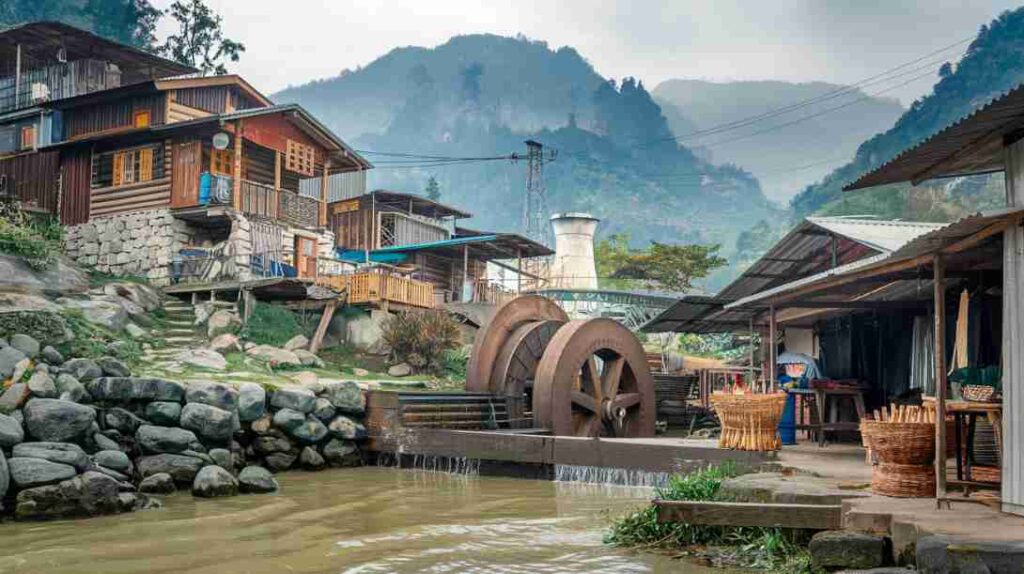
Main Attractions
- Traditional H’mong Architecture: The alluring wooden houses built on rocks exhibit craftsmanship of great architectural value.
- Cat Cat Waterfall: The combination of three small streams which are Tien Sa, Golden, and Silver form a powerful single flow which becomes stunning cascade.
- French Hydroelectric Plant: Now used as a place to host cultural performances.
- Giant Water Wheels: Bamboo water wheels of the locals show us amazing engineering skills.
- Handicraft Workshops: This is a place where the locals do their traditional weaving, dyeing, and silversmithing.
Activities and Experiences
Travelers heading to Cat Cat have the opportunity to have an unforgettable experience:
- See cultural shows of local music and dance (usually two times a day)
- Put on traditional H’mong dresses and take unforgettable photographs.
- Taste the ancient local corn wine.
- Buy real hand-made crafts and stitched pieces.
- Witness how indigo dyeing is done the traditional way.
- Appreciate peaceful scenery from different locations.
Practical Information
Admission Price:
150,000 VND (USD 5.8) for adults, 70,000 VND (USD 2.7) for children between 1m-1.4m. Free for those below 1m.
Location:
A simple 30-minute stroll or a quick taxi drive from Sapa town.
Operating Hours:
7 AM to 5 PM every day.
Ta Phin Village
Located roughly 14 kilometers northeast of Sapa town, the Dao Red Ta Phin village is known for its authentic ethnic culture and is inhabited by the Dao Red people.
The Red Dao People
While trekking, Sapa’s Ta Phin village is home to over 700 Red Dao people. The Red Dao maintain a unique cultural identity with distinctive religious practices, traditional attire, and social customs. They migrated from China between the 12th century and early 20th century.
Unique Cultural Elements
- Traditional Costume: Red Dao women are famously known for their elaborate red headdresses which are decorated with silver coins and tassels alongside beautifully stitched clothes.
- Religious Practices: The village contains dedicated spaces for ancestor worship and various spirits (house, kitchen, door), with unique rituals signaling when entry to homes is forbidden.
- Medicinal Knowledge: The Red Dao have gained fame for their skill in herbal medicine, especially for their herbal baths.
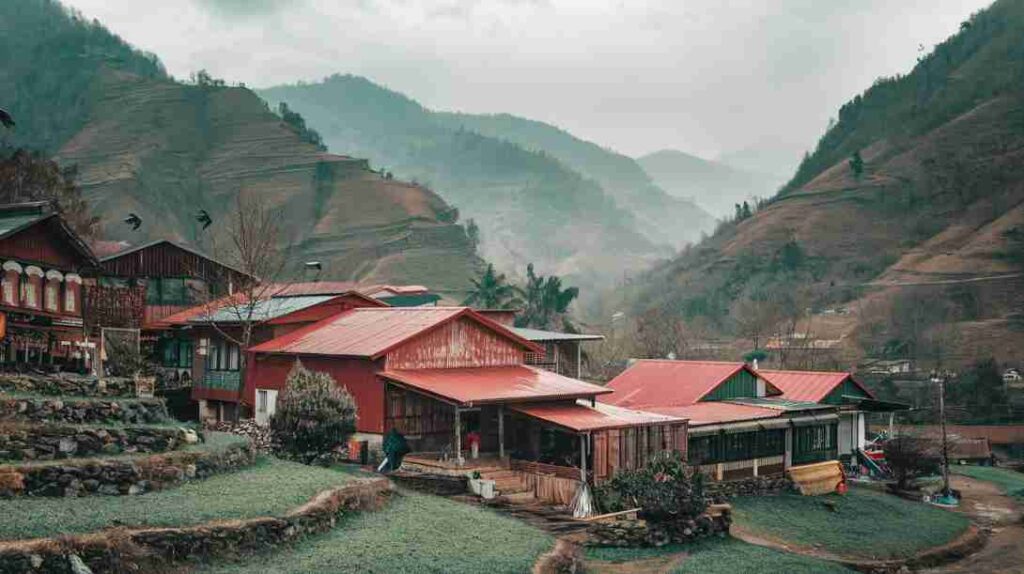
Activities and Experiences
- Try out the famous Red Dao herbal baths, which many say have great healing benefits.
- Hand-embroidered textiles can be directly bought from the artisans.
- Take a walk to the Ta Phin cave and enjoy the beautiful sights of its stalactites.
- Spend a night at a homestay which allows you to see how people live day-to-day.
- Walk in the nature around the valley, which has beautiful views of rice paddles, and goes for days.
Practical Information
- Distance: 14 km from Sapa Town, approximately 30-40 minutes by car
- Best Visit Time: With a guided trek or arranged transport
- Recommended Stay: Half a day or stay overnight for the complete experience
Lao Chai and Ta Van Villages
Hidden in the Muong Hoa Valley and its stunning terraced rice fields of Vietnam, these two villages are frequently visited in a single trip.
Landscape Features
Located about 9 km southwest of Sapa town, Lao Chai village is along the main road, with Ta Van roughly 3 km from it. Sightseeing in this area includes;
- Widespread terraced rice paddies that are sculptured to the curves of the mountains
- The Muong Hoa stream which flows quietly and clearly
- Bamboo thickets alongside vibrant green plant life
- The astonishing and bold range of Hoang Lien Son mountains serves as the backdrop
Cultural Aspects
Lao Chai is primarily inhabited by the Black H’mong tribe while the Giay ethnic minority group resides in Ta Van. This proximity of different ethnic groups allows tourists to experience a wide array of cultures, architecture, and handicrafts within a short distance. Origin Vietnam.
Trekking Routes
Easy Route: Lao Chai to Ta Van Trek
This hike is well sloped and manageable- perfect for the Sapa first-timer as it still offers stunning views without too much strain. The distance is about 6-8km which passes through bamboo groves and beautiful terraced rice fields. Offering both stunning visual and rich cultural experiences, this trail is well known for these features along with the chance to meet local indigenous people.
Moderate Route: Tả Van – Lao Chai via Lao Chai Bridge
This trek is rated as moderately challenging. It takes approximately 2 hours and 10 minutes to hike, and offers great views of the landscape including rice terraces and mountains. If the trails are muddy, this trekking path can become somewhat tricky, so the right shoes are advised.
Tricky Aspects
The difficult aspects, especially for the moderate route, Mud becomes slippery after rain. It is best to go with a local guide during these sections for safety and local perspectives. Moreover, the altitude changes and geography may be difficult even for the occasional hiker.
Perhaps the most famous trekking route is a picturesque 8 km walk from Sapa town that goes through both Muong Hoa villages
- Start from the stone church in Sapa town.
- Proceed to Muong Hoa street exiting the town.
- Go deeper into the valley via the terraced agricultural fields.
- Arrive at Lao Chai village which will serve as a resting stop.
- Head towards Ta Van where you can have lunch or spend the night.
The Vietnamese Cape Tours offer moderate treks which take around 3 to 4 hours to complete, with stunning views along the way.
Homestay Opportunities
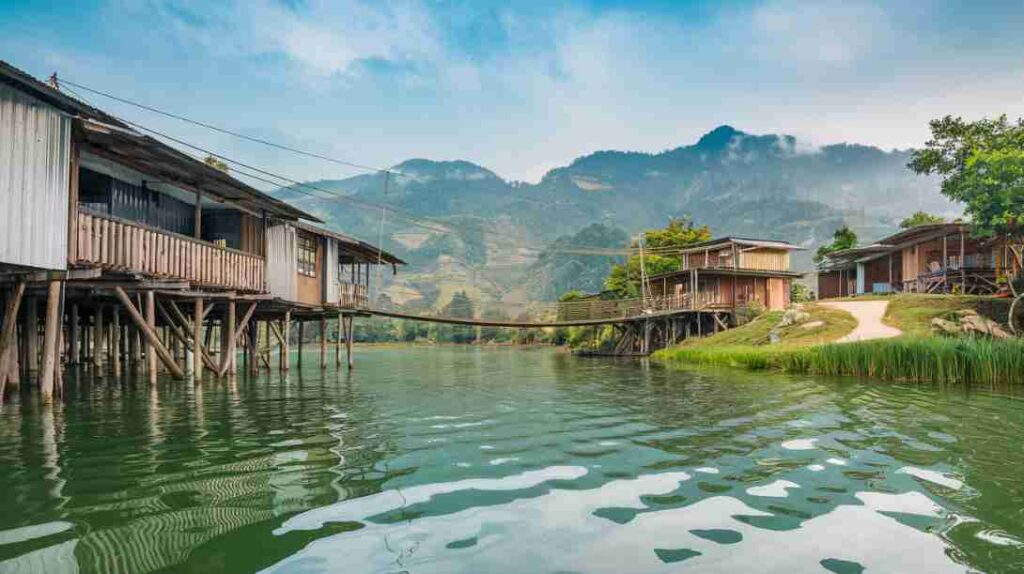
Regularly Ta Van enhances his homestay facilities making it perfect for TnT overnight stays. Basic comforts such as:
- Traditional Giay stilt houses as well as other silt houses.
- Local specialties as well as home-cooked meals.
- Cultural exchanges with families who host them.
- and seeing rice terraces in the morning, partially covered with mist.
Sin Chai Village
Sin Chai, located only 2 km beyond Cat Cat village, provides a quieter option with unfiltered views of H’Mong life and culture.
Less Touristic Experience
Sin Chai, a village near Sapa town (approximately 5 km away), is less visited compared to Cat Cat which allows for a more authentic experience of local life. Its traditional wooden H’mong houses, alongside with the families that still practice farming and other agricultural activities for centuries, are located along a narrow road.
Traditional Life
In Sin Chai, tourists can see:
- Daily farming practices in traditional ways
- Architectural features of H’mong wooden houses
- Children in ethnic costume practicing traditional games
- Shopping and cooking in the local market
How to Visit
- Accessible via motorbike or as part of a trekking tour from Cat Cat village
- No entrance fee (unlike Cat Cat)
- Best visited in the morning when villagers are most active
- Can be combined with Cat Cat for a full-day experience
Y Linh Ho Village
Positioned between Sapa town and Muong Hoa valley, Y Linh Ho offers excellent trekking opportunities through less-visited terrain.
Trekking Highlights
Easy Route
With respect to the difficulty level, the trekking route from Cat Cat to Y Linh Ho is considered quite simple. Involving a walk through ethnic villages as well as picturesque rice paddies, this path is short enough to provide an enjoyable trekking experience that is usually completed in a few hours.
Moderate Route
Many people consider the path from Y Linh Ho to Lao Chai to Ta Van to have a medium level of difficulty. The total distance of around 10 km incorporates different types of landscapes which includes some hills making the trek moderately challenging for people used to walking longer distances.
Tricky Aspects
Proper footwear should be combined with the help of a local guide, especially for the Y Linh Ho trekking route challenges. Local experts will make navigating the muddy sophisticated pathways safe and comfortable.
Y Linh Ho is well-known for its difficult yet satisfying trekking routes:
- High altitude areas offer breathtaking views
- Paths wind through cultivated fields as well as bamboo groves
- Lower concentration of tourists enhances the peace and quiet while trekking
- Frequently completed as part of longer treks to Lao Chai and Ta Van
Cultural Elements
The village is mostly populated by Black H’mong people who still practice:
- Hand-woven textiles and indigo dyeing
- Traditional wooden houses designed for the mountains
- Agriculture based on the seasons
- Local shops also sell their crafts
Landscape Features
Y Linh Ho’s location has unique scenic elements like:
- Steep hill sided terraced farmlands.
- Minor streams and waterfalls.
- Diverse dense forest regions.
- Wide views of Muong Hoa valley.
Ho Village (Ban Ho)
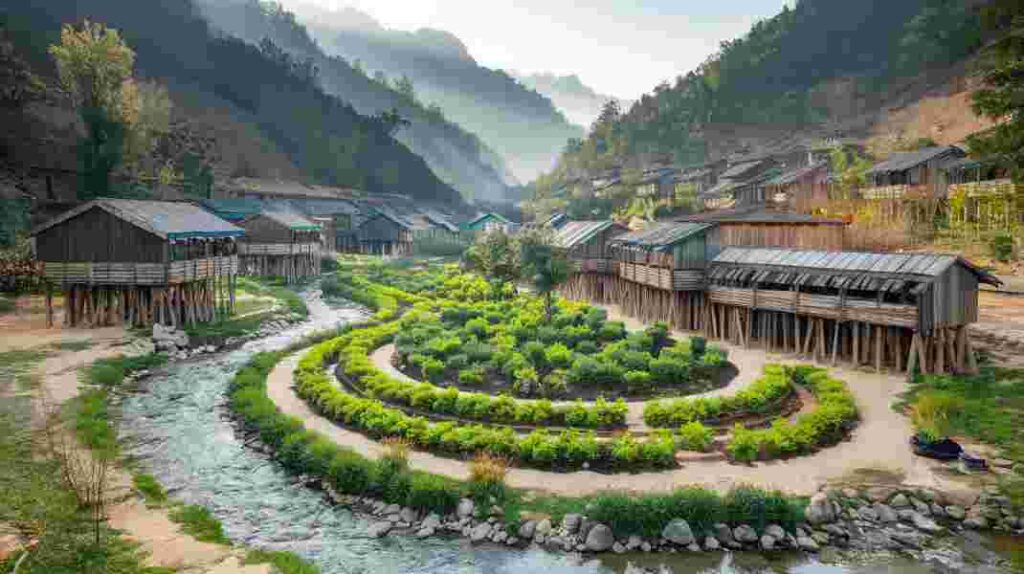
Around 30 km from Sapa town, Ho village (or Ban Ho) is the only village in the region that is populated by the Tay ethnic minority and provides a unique cultural experience.
Tay Ethnic Minority Features
The Tay people have unique cultural characteristics:
- Their own language and traditional dress
- Distinctive agricultural practices
- Special festivals and religious ceremonies
- Traditional music and dance forms
Traditional Stilt Houses
The stilt houses of Ban Ho are beautifully preserved:
- Made of wooden columns elevated over the ground
- Spacious living quarters for extended families
- Architectural features characteristic of Tay culture
- Frequently encircled by gardens planting healing herbs
River and Natural Attractions
The village’s topography provides:
- Nestled in a quaint valley, the peaceful Muong Hoa stream winds through it.
- Sunbathing and swimming in pristine water pools situated in the mountains.
- Flourishing plant life and rich animal species.
- Nearby regions posses spas with hot spring water.
Homestay Options
Ban Ho provides some of the most authentic homestay experiences:
- Unique local food specialties of Tay ethnic group
- Cultural evenings with host family members
- Joining in the family’s daily routines and farming activities
- Staying in stilt houses built in the Tay ethnic style
How to Experience Sapa Villages
Guided Trekking Tours
The Sapa trekking tours are the most popular guided activities of the region:
- Day Tours: Usually cover 1-2 villages and are led by English-speaking guides (frequently local ethnic minorities)
- Multi-Day Tours: Feature overnight homestay rests in villages such as Ta Van or Ban Ho.
- Custom Tours: Designed to intriguing individual preferences (photography, cultural immersion and etc.).
- Group Size: From private tours to small group tours of 8-10 people.
You can arrange for many tours through your hotel in Sapa, or book them with trusted agencies prior to arriving.
Homestay Experiences
For deep cultural engagement, an overnight stay in a village homestay is strongly recommended:
- Simple Acommodations: Usually a mattress on the floor with a mosquito net and warm blankets.
- Family Meals: Takes meals together with hosts and some guests.
- Cultural Exchange: Evening conversations and other activities with the family.
- Morning Experience: Get up to the village daily activities with roosters crowing, other people cooking, and daily chores.
Cultural Immersion Opportunities
In addition to trekking and homestays, think about these cultural activities:
- Cooking Classes: Get to know the local culture by cooking with local ingredients.
- Craft Workshops: Learn how to indigo dye, weave, or embroider.
- Market Visits: Enjoy local vibrant markets on specific days (some are weekly).
- Traditional Ceremonies: If the timing is right, you can also participate in local festivals or ceremonies.
Responsible Tourism Tips
While touring these villages, please use responsible tourism practices:
- Kindly ask before taking portraits of individuals
- Buy souvenirs directly from the craftsmen
- Observe local traditions and dress appropriately
- Use local tour guides to help the community economically
- Reduce the use of plastic waste and bring back what you take in
Trekking Routes Between Villages
Popular Multi-Village Routes
Several established trekking routes connect multiple villages:
- Sapa – Cat Cat – Sin Chai (Easy, half-day)
- Distance: 5-6 km
- Highlights: Waterfall, cultural performances, less touristy areas
- Terrain: Mostly paved paths with some steps
- Sapa – Lao Chai – Ta Van (Moderate, full-day)
- Distance: 8-10 km
- Highlights: Spectacular rice terraces, two different ethnic villages
- Terrain: Mix of dirt trails and some steep sections
- Y Linh Ho – Lao Chai – Ta Van (Moderate, full-day)
- Distance: 10-12 km
- Highlights: Off-the-beaten-path, varied landscapes
- Terrain: More challenging trails with some muddy sections
- Sapa – Ma Tra – Ta Phin (Moderate, full-day)
- Distance: 7-9 km
- Highlights: Red Dao culture, Ta Phin cave, herbal baths
- Terrain: Mix of asphalt road and countryside trails
Difficulty Levels and Duration
Trekking difficulty varies by route and season:
- Easy: Suitable for anyone with basic fitness, minimal elevation change
- Moderate: Requires reasonable fitness, some steep sections
- Challenging: Substantial elevation changes, possibly slippery in wet conditions
Durations range from 2-3 hours for short treks to 6-7 hours for full-day adventures.
Scenic Highlights
Each trekking route offers unique scenic highlights:
- Rice Terraces: Best viewed in Lao Chai and Ta Van areas
- Waterfalls: Most impressive at Cat Cat and Silver Waterfall
- Mountain Views: Clearest from higher elevation points near Y Linh Ho
- River Scenes: Most picturesque along the Muong Hoa stream in Ta Van
- Forest Trails: Most enjoyable between Y Linh Ho and Lao Chai
Homestay Experiences in Sapa Villages
What to Expect
Genuine homestays in Sapa’s villages offer glimpses into the actual life of local people.
- Sleeping Arrangement: The traditional steppe includes basic straw mats on the ground or lofty beds, mostly with mosquito nets and warm blankets.
- Bathroom Facilities: Basic with squat toilets, in upgraded homestays more modern facilities are available.
- Shared Living: Shared rooms with the hosts’ families or other guests.
- Late Night Activities: Chatting around a fire, listening to tales, drinking rice wine, and sometimes engaging in traditional songs or games.
- Local Dishes: Cooked from scratch, meals with fresh vegetables and other ingredients bought from local markets.
How to Book
There are several ways to arrange a homestay experience:
- Through Trekking Tours: Many organized trekking packages include homestays
- Via Hotels in Sapa: Most Sapa hotels can arrange village homestays
- Online Platforms: Some homestays are listed on conventional booking sites
- Direct Arrangements: Some travelers make arrangements in-person upon arrival at villages
- Local Guide Connections: Local guides often have family or community connections in villages
Cultural Etiquette
To keep interactions positive:
- Take off footwear upon entering houses
- Request approval prior to capturing any images
- Present modest tokens (sweets or fruits) as appreciation
- Engage in family’s pastimes when extended an invitation
- Welcome the chance to sample local delicacies and practices
- Honor family members’ private time and rest periods
Typical Amenities
Most homestays offer basic amenities:
- Bedding (mattress, blankets, pillows)
- Mosquito nets
- Shared bathroom facilities
- Home-cooked meals
- Drinking water
- Sometimes Wi-Fi (in more developed villages like Ta Van)
Practical Tips for Visiting Sapa Villages
What to Pack
Important things to bring when visiting villages are:
- Footwear: Durable, waterproof hiking shoes or boots.
- Clothing: Multiple layers to protect from the cold.
- Rain Gear: Waterproof coat and backpack rain cover.
- Sun Protection: Hat, sunglasses, and sunscreen protects skin from harsh rays.
- To repel insects: Very useful during wings carrying summer season.
- Water Bottle: Stable and refillable to prevent plastic pollution.
- Basic first Aid Kit: consisting of blister plasters, and general pain relief medication.
- Cash: small unit currencies of Vietnamese Dong. (Unable to withdraw cash using ATM in rural villages)
Transportation Options
Getting to and between villages:
- Walking/Trekking: The most immersive way to experience the landscape
- Motorbike: Rental or with drivers available in Sapa town
- Taxi/Private Car: Convenient for reaching further villages like Ban Ho
- Shared Vans: Budget option for reaching major villages
- Cable Car: Reaches Fansipan mountain with views of surrounding villages
Local Customs and Etiquette
Respecting local customs enhances your experience:
- Make sure to dress conservatively, particularly when going to people’s homes or participating in ceremonies.
- Greet villagers warmly with a smile and a few basic Vietnamese words.
- Always ask for permission before entering private areas.
- Allow time for slow interactions—villagers might not share your sense of time.
- Get to know gift-giving etiquette if you’re going to be placed with local families.
Photography Considerations
For respectful and rewarding photography:
- Always ask permission before photographing people
- Offer to show people their photos on your camera
- Consider paying a small amount if someone poses for a portrait
- Be aware that some ceremonies or rituals may prohibit photography
- Early morning offers the best light for landscape photography, especially with misty conditions
Conclusion
The Sapa countryside is stunning both in view and traditional culture. Adapting to the area’s mountainous landscape over centuries, each village boasts its own character—from Cat Cat’s accessible cultural showcase to Ta Phin’s authentic Red Dao encounters and pristine rice terrace sights of Lao Chai and Ta Van.
Gaining hands-on knowledge of traditional crafts, staying overnight with local families, or simply trekking from one village to another creates unforgettable memories that linger long after saying goodbye to Vietnam’s misty mountains. While planning the trip, consider the fact that preserving tourism aids in maintaining the uniqueness of these communities for years to come.
The surrounding villages of Sapa are more than just highland travel destinations, instead, they are windows through which to understand Vietnam’s rich culture and indomitable spirit.
FAQs
How many ethnic minority groups live in the villages around Sapa?
In the Sapa region, multiple ethnic minorities live: the H’mong (Black H’mong), Red Dao, Giay, Tay, and Xa Pho. Each of these groups has their own language, custom, and style of traditional attire.
Can I visit Sapa villages independently or do I need a guide?
Even though travelers can go to some villages like Cat Cat on their own, having a local tour guide enriches the experience greatly since they tell the stories behind what the traveler sees, help them interact with the local villagers, and help them avoid the more hidden paths. For far-off villages, having a guide is highly advisable.
How physically demanding are the treks between Sapa villages?
The most popular routes, including Cat Cat village, Lao Chai-Ta Van, and Y Linh Ho, vary in difficulty from easy, moderate to challenging respectively. While the most frequented paths aren’t very technical, they do require a general level of fitness and the right shoes. Weather, especially during the rainy season, can make things harder.
What’s the difference between staying in Sapa town versus a village homestay?
Sapa town features modern conveniences such as restaurants and hotels, while village homestays offer authentic cultural immersion alongside traditional meals and glimpses of everyday life. Many tourists combine the two, spending some nights in Sapa and others in village homestays.
5. Is it ethical to visit these ethnic minority villages?
Responsible operators who care for the local communities make ethical tourism possible. Hire guides from ethnic minorities, buy crafts directly from artists, and respect their photo boundaries. Participate in tourism that is community-based as opposed to exploitative “human zoos.”

